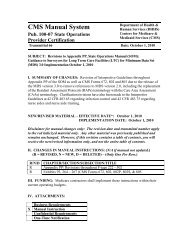2003 Louisiana Vital Statistics Report - Louisiana Department of ...
2003 Louisiana Vital Statistics Report - Louisiana Department of ...
2003 Louisiana Vital Statistics Report - Louisiana Department of ...
You also want an ePaper? Increase the reach of your titles
YUMPU automatically turns print PDFs into web optimized ePapers that Google loves.
TECHNICAL NOTES <strong>2003</strong> LOUISIANA VITAL STATISTICS REPORT<br />
plus fetal deaths occurring in the population during the same time period, then multiplying the quotient by 1,000. Fetal mortality<br />
rates are expressed as the number <strong>of</strong> fetal deaths per 1,000 live births plus fetal deaths.<br />
FIRST BIRTH RATE: a measure <strong>of</strong> the number <strong>of</strong> first births, to mothers in a particular age group, during a given period. First<br />
birth rates are calculated by dividing the number <strong>of</strong> first births to mothers in a particular age group during one year by the total<br />
female population in that age group, then multiplying the quotient by 1,000. The rates are expressed as the number <strong>of</strong> births per<br />
1,000 women in that age group. First birth rates are helpful in assessing changes over time in the age at which women begin<br />
bearing children.<br />
GESTATIONAL AGE (Live Birth data): the interval between the first day <strong>of</strong> the mother’s last normal menstrual period and the<br />
date <strong>of</strong> birth. Physicians use several different methods to estimate gestational age, including computing the interval between<br />
the first day <strong>of</strong> the mother’s last normal menstrual period (LMP) and the date <strong>of</strong> birth, or determining a clinical estimate based on<br />
examination <strong>of</strong> the newborn. Standardized methods <strong>of</strong> measurement for determination <strong>of</strong> gestational age are difficult, especially<br />
among at-risk pregnancies in which minimal or no prenatal ascertainments are made. <strong>Louisiana</strong> Birth Certificates record both<br />
the “Date Last Normal Menses Began” and the “Clinical Estimate <strong>of</strong> Gestation.” LMP is subject to error from imperfect maternal<br />
recall or misidentification <strong>of</strong> the last normal menstrual period because <strong>of</strong> post-conception bleeding, delayed ovulation, or<br />
intervening early miscarriage. Therefore, the physician’s clinical estimate <strong>of</strong> gestation is used to determine gestational age in<br />
this report.<br />
GESTATIONAL AGE (Fetal Death data): the interval between the first day <strong>of</strong> the mother’s last normal menstrual period and the<br />
date <strong>of</strong> delivery. Prior to 1995, “Clinical Estimate <strong>of</strong> Gestation” was not recorded on <strong>Louisiana</strong>’s Fetal Death Certificate.<br />
Consequently, gestational ages reported for years prior to 1995 were calculated by subtracting the “Date Last Normal Menses<br />
Began” from the “Date <strong>of</strong> Delivery,” as recorded on the Fetal Death Certificate. Beginning with the 1997 <strong>Louisiana</strong> <strong>Vital</strong><br />
<strong>Statistics</strong> <strong>Report</strong>, gestational ages for fetal deaths occurring in or after 1995 are reported based upon the National Center for<br />
Health <strong>Statistics</strong> formula for calculation <strong>of</strong> gestational age for fetal deaths. This formula calculates gestational age by combining<br />
information collected in the “Date Last Normal Menses Began” and “Clinical Estimate <strong>of</strong> Gestation” sections <strong>of</strong> the Fetal Death<br />
Certificate.<br />
HEBDOMADAL DEATH: a representation <strong>of</strong> deaths occurring to infants under 7 days <strong>of</strong> age. See PERINATAL MORTALITY.<br />
HEBDOMADAL MORTALITY RATE: a measure <strong>of</strong> deaths to infants under 7 days <strong>of</strong> age during a given period. Hebdomadal<br />
mortality rates are calculated by dividing the number <strong>of</strong> deaths to infants under 7 days <strong>of</strong> age occurring in a given population<br />
during one year by the number <strong>of</strong> live births occurring during that year, then multiplying the quotient by 1,000. The rate is<br />
expressed as the number <strong>of</strong> deaths to infants under age 7 days, per 1,000 live births.<br />
ICD-10: the tenth revision <strong>of</strong> the International Statistical Classification <strong>of</strong> Diseases, Injuries, and Causes <strong>of</strong> Death. Please see<br />
the Death Data section <strong>of</strong> these Technical Notes.<br />
INDUCED TERMINATION OF PREGNANCY (INDUCED ABORTION): the purposeful interruption <strong>of</strong> pregnancy with intention<br />
other than to produce a live infant or to remove a dead fetus, in which the intervention does not result in a live birth.<br />
Page 166 <strong>Louisiana</strong> Office <strong>of</strong> Public Health, State Center for Health <strong>Statistics</strong>
















